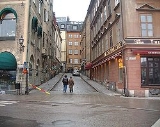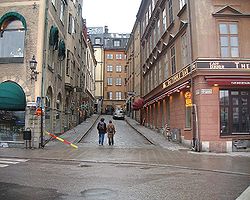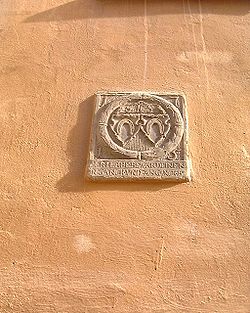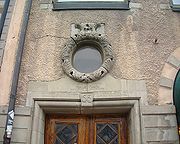
Funckens Gränd
Encyclopedia
 |
 |
 |
 |
Funckens Gränd (Swedish
Swedish language
Swedish is a North Germanic language, spoken by approximately 10 million people, predominantly in Sweden and parts of Finland, especially along its coast and on the Åland islands. It is largely mutually intelligible with Norwegian and Danish...
: "Alley of [the] Funck") is an alley
Alley
An alley or alleyway is a narrow lane found in urban areas, often for pedestrians only, which usually runs between or behind buildings. In older cities and towns in Europe, alleys are often what is left of a medieval street network, or a right of way or ancient footpath in an urban setting...
in Gamla stan
Gamla stan
Gamla stan , until 1980 officially Staden mellan broarna , is the old town of Stockholm, Sweden. Gamla stan consists primarily of the island Stadsholmen. The surrounding islets Riddarholmen, Helgeandsholmen, and Strömsborg are officially part of, but not colloquially included in, Gamla stan...
, the old town in central Stockholm
Stockholm
Stockholm is the capital and the largest city of Sweden and constitutes the most populated urban area in Scandinavia. Stockholm is the most populous city in Sweden, with a population of 851,155 in the municipality , 1.37 million in the urban area , and around 2.1 million in the metropolitan area...
, Sweden
Sweden
Sweden , officially the Kingdom of Sweden , is a Nordic country on the Scandinavian Peninsula in Northern Europe. Sweden borders with Norway and Finland and is connected to Denmark by a bridge-tunnel across the Öresund....
. Leading south from the street Västerlånggatan
Västerlånggatan
Västerlånggatan is a street in Gamla stan, the old town of Stockholm, Sweden. Stretching southward between the squares Mynttorget and Järntorget, it follows the course of the city's now demolished 13th century defensive wall....
to the square Kornhamnstorg
Kornhamnstorg
Kornhamnstorg is a public square in Gamla stan, the old town in central Stockholm, Sweden.Old names : Kornhaffn , Jernboen , Åkaretorget , Kornhampns torget...
, it forms a parallel street to Torgdragargränd
Torgdragargränd
Torgdragargränd is an alley in Gamla stan, the old town in Stockholm, Sweden. Stretching from the street Västerlånggatan to the square Kornhamnstorg, it forms a parallel street to Tyska Brinken and Funckens Gränd...
and Triewaldsgränd
Triewaldsgränd
Triewaldsgränd is an alley in Gamla stan, the old town in central Stockholm, Sweden. Stretching south from the square Järntorget to Kornhamnstorg and Munkbroleden, it forms a parallel street to Funckens Gränd and Järntorgsgatan....
.
Origin of the name
The street appears in historical records in 1666 as Funckens grendh, named after the burgher Tomas Funck (1580–1645) who moved to Stockholm from StralsundStralsund
- Main sights :* The Brick Gothic historic centre is a UNESCO World Heritage Site.* The heart of the old town is the Old Market Square , with the Gothic Town Hall . Behind the town hall stands the imposing Nikolaikirche , built in 1270-1360...
. The Funck family owned several properties in the alley, except for the so called Funck House (Funckska huset) on 53, Kornhamnstorg, also one on the opposite side of the alley. As the daughter-in-law of Tomas Funck, Elisabet Hansdotter, bought other neighbouring properties in 1680 and 1698, most of the alley belonged to the family, and as the alley's earlier name Bredgränd
Bredgränd
Bredgränd is an alley in Gamla stan, the old town of Stockholm, Sweden. Stretching from Skeppsbron to Österlånggatan, it forms a parallel street to Skeppar Karls Gränd and Kråkgränd.- Origin of the name :...
(17th century) was used for other streets, the family therefore gave its name to the alley. In the middle of 16th century it was named Stråbucksgränd or Henrik Stråbucks gränd.
A walk north to south
The present building on Number 1 (Deucalion 10) is the product of a reconstruction in the 20th century when two older buildings (Deucalion 4 & 5) were merged. They were separated by a medieval alley parallel to Funckens Gränd, of which remains a narrow and elongated backyard passing through the present block. All other traces of the medieval neighbourhood have been obliterated by repeated reconstructions over hundreds of years. In historical records, various properties in the block have been merged and partitioned at numerous occasions. In the mid 17th century, the building was owned by a Mrs. Brita Grönberg, but was by the end of that century taken over by the Funck family. It is described in the mid 18th century as four stories tall and furnished with a stone portal, but was, however, completely rebuilt in 1867.The building on Number 3 (Deucalion 6) is what remains of a property which once stretched along the entire alley. It was owned by Mrs. Brita Grönberg, daughter to the merchant Mårten Trotzig who gave Mårten Trotzigs Gränd
Mårten Trotzigs Gränd
Mårten Trotzigs gränd is an alley in Gamla stan, the old town of Stockholm, Sweden. Leading from Västerlånggatan and Järntorget up to Prästgatan and Tyska Stallplan, the width of its 36 steps tapers down to a mere 90 cm, making the alley the narrowest street in Stockholm.The alley is named...
its name. Following the death of the former, the property was partitioned in three. The stone table on the façade from 1715 carries the initials and symbol of Gustaf Hästesko ("Gustav Horseshoe"). The building have been rebuilt at several occasions since, the top floor is from 1755.
The façade of Number 5 (Deucalion 7), on the corner to Kornhamnstorg, got its present appearance in the 19th century, while the backyard is keeps its older look. On a painting from the 1790s the building appears with a stepped gable facing the square.
Number 2 (Typhon 1) carries wall anchors displaying L L D L 1627, the initials of Lydert Lang and Dorotea Lang.
According to an inscription from 1908 on 53, Kornhamnstorg, the building on Number 4 (Typhon 18) was built by Thomas Funck who gave the alley its name. The inscription is however wrong, Thomas lived on 59, Kornhamnstorg, but his son Johan Funck lived in this building and, having made a fortune on copper production, bought many other buildings in the city, just like did his widow. The stone inscription is however right in the claim the present building was rebuilt in the early 20th century to the design of Ferdinand Boberg
Ferdinand Boberg
Ferdinand Boberg, born 11 April 1860 in Falun, died 7 May 1946 in Stockholm, was a Swedish architect.He was one of the most productive and prominent architects of Stockholm around the turn of the 20th century. Among his most famous work is an electrical plant at Björns Trädgård in Stockholm, that...
, the architect who designed the Stockholm City Hall
Stockholm City Hall
Stockholm City Hall is the building of the Municipal Council for the City of Stockholm in Sweden. It stands on the eastern tip of Kungsholmen island, next to Riddarfjärden's northern shore and facing the islands of Riddarholmen and Södermalm. It houses offices and conference rooms as well as...
.
External links
- http://www.hitta.se/SearchCombi.aspx?__VIEWSTATE=%2FwEPDwUKMTg4NDI3NTMzNWRk&UCSB%3AWflWhite=1a1b&UCSB%3AWflPink=4a&SearchType=4&UCSB%3ABBX1=&UCSB%3ABBY1=&UCSB%3ABBX2=&UCSB%3ABBY2=&UCSB%3ATextBoxWho=&UCSB%3ATextBoxWhere=Funckens+Gr%E4nd&UCSB%3AButtonSearch=%A0%A0hitta%21%A0%A0&CombiDetails%3AMapControl%3Acx=1628991&CombiDetails%3AMapControl%3Acy=6580169&CombiDetails%3AMapControl%3ApointsHidden=&CombiDetails%3AMapControl%3Az=2hitta.se - location map and virtual walk]
- Stockholmskällan - Historical photos
- Google Maps

